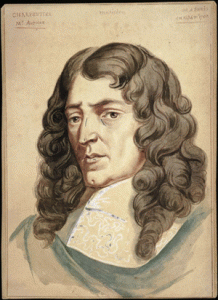Magnificat To Perform Oratorios by Marc-Antoine Charpentier March 6-8
 On the weekend of March 6-8 2015, Magnificat will perform two oratorios by Marc-Antoine Charpentier: Historia Esther and Judith, ou Béthulie libérée. The program will also include Charpentier’s setting of Psalm 137, Super flumina Babylonis and the Canticum in honorem beata Virginis Mariae. Sopranos Laura Heimes and Catherine Webster, copuntertenor Andrew Rader, tenor Daniel Hutchings and bass Peter Becker will be joined by an instrumental ensemble including Vicki Boeckman and Louise Carslake, recorder, Rob Diggins and Jolianne Einem, violin, John Dornenburg, viola da gamba and Jillon Stoppels Dupree, organ.
On the weekend of March 6-8 2015, Magnificat will perform two oratorios by Marc-Antoine Charpentier: Historia Esther and Judith, ou Béthulie libérée. The program will also include Charpentier’s setting of Psalm 137, Super flumina Babylonis and the Canticum in honorem beata Virginis Mariae. Sopranos Laura Heimes and Catherine Webster, copuntertenor Andrew Rader, tenor Daniel Hutchings and bass Peter Becker will be joined by an instrumental ensemble including Vicki Boeckman and Louise Carslake, recorder, Rob Diggins and Jolianne Einem, violin, John Dornenburg, viola da gamba and Jillon Stoppels Dupree, organ.
Friday March 8 2015 8:00 pm St. Mark’s Episcopal Church, 600 Colorado Ave., Palo Alto
Saturday March 7 2015 8:00 pm First Congregational Church, 2345 Channing Way, Berkeley
Sunday March 8 2015 4:00 pm St. Mark’s Lutheran Church, 1111 O’Farrell, San Francisco
There will be a lecture 45 minutes before each performance given by noted Charpentier scholar and Magnificat Artistic Advisory Board member John S. Powell. Dr. Powell has also provided notes for the concerts which are posted on this blog. Tickets are available at http://magnificatbaroque.tix.com or by calling 800-595-4849.
Among 17th-century French composers, Marc-Antoine Charpentier made the largest contribution to the development of the French oratorio. This emphasis in Charpentier’s early sacred output is largely due to circumstance. Upon his return from Rome and his studies with Giacomo Carissimi in the late 1660s, Charpentier took residence in the Hôtel de Guise (now the Hôtel de Soubise) in the Marais District of Paris under the patronage of Marie de Lorraine (Mademoiselle de Guise). Charpentier remained in her service for some eighteen years, from around 1670 until her death in 1688. Three years before Charpentier’s arrival in Paris, Elizabeth d’Orléans, the youngest daughter of Gaston d’Orléans (uncle to Louis XIV), married Louis-Joseph, the nephew of Mademoiselle de Guise. Charpentier thus found himself in the service of Elizabeth d’Orléans (Madame de Guise) as well as of Mademoiselle de Guise. Both ladies were very devout and actively supported religious teaching institutions in Paris. Under the patronage of Mlle and Mme de Guise, Charpentier created a large number of devotional and oratorio-like works.
Like his teacher Carissimi, Charpentier composed numerous works that reveal the different stages in the development of the Latin oratorio from the motet. Indeed, Charpentier described as motets many of the compositions that are viewed by us as oratorios. These thirty-four works fall into three main groups: historiae, cantica, and dialogi. The fourteen historiae are the most elaborate and are clearly influenced by the style and structure of Carissimi’s largest historiae. Moreover, the musical demands of the historiae are in proportion to their length. In addition to soloists and basso-continuo, a chorus is always required, and is frequently split into two equal half-choruses. Concertante instruments—as few as two violins, as many as two four-part string orchestras—are often added to the continuo.
In some of his oratorio titles Charpentier uses the term canticum. Besides the strict liturgical meaning of this term (“song”), Charpentier’s use of the term canticum seems to have been almost synonymous with “oratorio” in 17th-century France. Many works labeled canticum include a narrator (historicus), which is a hallmark of the oratorio. The semi-dramatic cantica of Charpentier are of two types: (1) works on subjects similar to those of the historiae, but lacking the expansiveness either of text or of musical treatment—in short, miniature historiae; (2) works of more reflective, lyrical, and less dramatic character, resembling in text and musical treatment the dramatic-narrative mottetto concertato of Carissimi and earlier Italians. The last type of oratorio-like composition written by Charpentier is the dialogus. The dialogi are characterized by dramatic situations that involve two persons or two groups of persons. They lack objectively descriptive texts or narrative elements, hence a historicus is unnecessary and does not typically appear. They are characteristically brief works, on the same scale as the cantica, and like the cantica they demand a minimum number of performers. As in the Italian biblical dialogues that undoubtedly served Charpentier as models, the two dialoguing elements join in simultaneous expression at the end of a work.